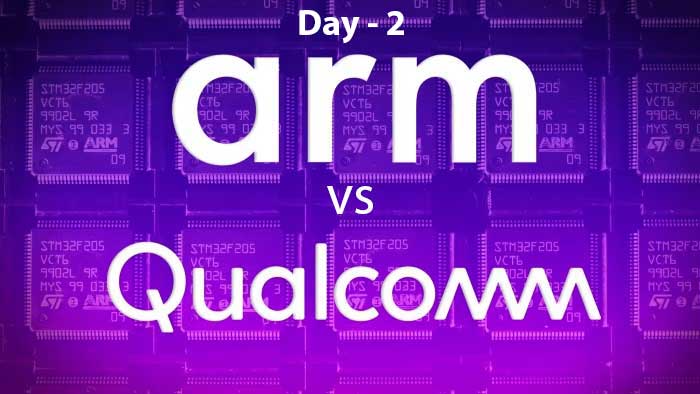18
Dec
Qualcomm vs. Arm trial, Day 2 – Is processor design derivative of Instructing set architecture (ISA)?
Summary of Day 2
Check out the summary of Day 1 here.
The second day had very interesting morning and boring afternoon sessions. The most important discussion was whether processor design and RTL are a derivative of Arm’s technology. During Nuvia founder, CEO, and now Qualcomm SVP Gerard Williams’s testimony, Arm’s lawyer tried to corner him into agreeing to that. She even pointed to the Nuvia ALA text, which seems to suggest that Nuvia’s technology is a derivative of Arm’s technology (Arm ARM – Architecture Reference Manual). But Gerard vehemently opposed and fought against it throughout his lengthy testimony.
This assertion of derivative seems an overreach and should put a chill down the spine of every Arm customer, especially the ones that have ALA, which include NXP, Infineon, TI, ST Micro, Microchip, Broadcom, Nvidia, MediaTek, Qualcomm, Apple, and Marvell. No matter how much they innovate in processor design and architecture, it can all be deemed Arm’s derivative and, hence, its technology.
Today Arm finished its testimonies, and Qualcomm started with its witnesses. Tomorrow, I expect to see Qualcomm vehemently fighting against Arm’s assertion and most likely see Qualcomm CEO Christian Amon take the witness stand.
Come back tomorrow for the third day’s update.
Highlights of Day 2:
The second day saw testimonies from Gerard Wiliams, a couple of expert witnesses, Jonathan Weiser, SVP of Qualcomm, and a product manager from Arm.
-
Arm tried to link Nuvia’s processor design work to ALA in many ways. Their lawyer grilled Gerard by showing many different parts of the contract, his presentations, internal emails, messages, and other things to prove this point. Gerard did a great job defending against all of them. However, an obscure explanation for the derivates of Arm’s technology (known as ARM – Architecture Reference Manual) in Nuvia’s ALA seems to indicate that Nuvia’s architecture (design and RTL code) is part of it. Gerard disagreed with it.
-
I am not a lawyer, so I don’t know how to interpret this seeming mention, and how strong will it stand. More importantly, how much weight Jury will give it., vis-à-vis all the testimony they have heard yesterday.
-
There were three expert witnesses today, two from Arm and one from Qualcomm. The first was Dr. Robert Colwell. He tried to say that processor designs are dependent on Arm ARM, but buckled during cross-examination because of inconsistencies in responses. Second was Dr. Shuo-Wei (Mike) Chen, who analyzed the RTL codes between Nuvia and Qualcomm cores and saw similarities, which was expected. Third was Dr. Murali Annavaram, who opined on Qualcomm’s claim about Arm using some other Nuvia’s IP without permission.
Key Points from the testimonies:
Gerard Williams
This was the longest and most consequential testimony.
-
Nuvia Founder and CEO, now Qualcomm SVP, previously worked for Apple and Arm
-
He looked a little bit unsure in the beginning but became confident as the questioning progressed
-
Rejected Arm’s claim that Nuvia needed approval from Arm for acquisition
-
Said he made sure during ALA negotiations that Nuvia had ownership of all the technology it developed, independent of Arm’s technology
-
Asserted that processor design and RTL code are independent of Arm’ ARM
-
Processors become Arm-compatible after they are certified as such, not when designing
-
When Nuvia designs were transferred to Qualcomm, they were still in design, so they were not yet Arm-compatible
-
Reiterated that Arm ARM is freely available on the internet for anybody to download, hence not confidential
-
Only the latest versions of the ARM are confidential and will eventually released on the internet
-
In compliance with ALA, Nuvia destroyed confidential information (latest, non-pubic ARM documents) during acquisition
-
Claimed ARM is not a recipe for creating a processor. Even if somebody fully studied the ARM they can’t design a processor
-
Explained how designing processors needs a lot of engineering talent and experience. That’s why he built a team with about 300 engineers (150 CPU experts + 150 System/SoC experts)
-
Nuvia first tried to use Arm’s TLA but ultimately decided to build its own cores using ALA, hence ended with both licenses
-
Nuvia ALA had a clause that made it null after any acquisition
-
Disagreed that Nuvia got a deep-discount deal, paid $22M
Dr. Robert Colwell – Arm’s expert witness
-
Ex-Intel, Ex-DARPA, previously consulted with Qualcomm
-
Opined that processor design and RTL are dependent on the architecture
-
Asserted that there was commonality in Arm RTL and Nuvia RTL
-
Buckled under cross-examination because of inconsistencies between the deposition statements and today’s testimony ( ISA is useless, stats used, etc.)
Dr. Shuo-Wei (Mike) Chen – Arm expert witness
-
Professor at USC, MS & PhD at UC Berkeley
-
Studied the commonality between Nuvia and Qualcomm cores
-
Code commonality: 57% in Compute, 47 % in Mobile, 37% in Auto, and 20% in new unnamed platforms
-
This is no surprise, as Qualcomm has readily agreed that it built its cores on Nuvia design
-
Since Compute was the first commercial solution, it had the highest commonality and went down as it was introduced in to other domains
Jonathn Weiser
-
30 years at Qualcomm, was involved in negotiating ALA and TLA
-
Qualcomm ALA and TLA signed in 2013, after 2-3 years of negotiations
-
Earlier TLA was signed in 1995, and TLA in 2003
-
ALA was amended in 2017
-
Qualcomm informed Arm in Jan 2021 that Nuvia engineers have joined Qualcomm and will be covered by the company’s ALA


1 comments